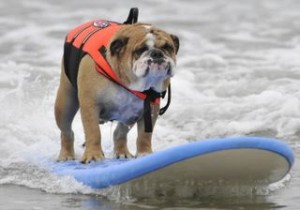There’s no limit to the kinds of fun you can have with your dog. When the days heat up, and summer is full on, what better way to have a good time (and burn energy) than to surf with your dog. Yeah, we know what you’re saying: Your dog would never go surfing. But thousands of dogs do it each year; why can’t yours?
The thing is, your dog can surf. It’s not a matter of his own abilities, but of your patience and commitment toward training him. With a well thought out plan and a cool demeanor, your dog could be surfing by the summer.
Follow these steps and before you know it, your dog will be a surf dog.
1. Get the right board. Step number one, above all else, is to get the proper surfboard for your dog. There’s plenty of debate on what makes a good dog board or not. Many people say foam’s the way to go, but foam can hurt your dog’s paws and can easily turn into a chew toy.
On the other hand, foam is a lot lighter, meaning if your dog wipes out and gets hit by his board, a foam board will be far more welcomed than, say, a fiberglass board.
You can also choose between small “boogie” boards, or longboards. Your best bet is to start with a small, foam boogie board, to give your dog the confidence he needs. Over time he may progress to fiberglass longboards.
2. The water. We know we just said that choosing the right board is numero uno, however, you also have to make sure your dog likes water. If you’re not sure, then don’t introduce both water and board at the same time. There are a number of ways you can safely introduce your dog to water so that he’s not afraid of it. Be sure your dog is confident in the water before you throw a board into the mix.
3. Start small. Don’t go into the Atlantic or Pacific for your first go-around. Try a pool or pond, any place where you don’t have to battle waves, and you can easily touch the ground.
Your first step is to have fun with your dog, in the water. Bring your board, but don’t formally introduce it. Let your dog sniff it out, touch it (treat him if you wish), and let him make the connection that this “thing” and the water equals a good time.
4. Dry run. Now that your dog knows the board in what will become its natural environment, it’s time to put him on it. But don’t do so in the water. While you’re out of the water, place your dog onto the board at his own pace. Don’t force him if he seems apprehensive. Maybe throw a few treats on the board to encourage him. When he gets on the board, place him where you’d prefer him to be (around ⅔ of the way back), and treat him for being where you want him to be.
5. The vest. Go through this dry run a few times, until your dog knows where to stand on the board. Once he’s comfortable, there’s one more thing you have to introduce, and that’s your doggie life vest. Even if your dog is an amazing swimmer, you want the vest. What if your dog gets injured and can’t swim well? What if you need to pull him back onto the board (or your own board) but can’t grab a hold of him when he’s wet? A vest will make all of this much easier to handle. You may want to introduce the vest in a place where your dog is extremely comfortable, like in your home. Give him treats as you put the vest on, and only make him wear it for a short while at first. Over time you can keep it on longer.
6. The run. Okay, your dog now knows how to stand on the board, and he knows that the vest is okay. It’s time to take him out on the water. Since you’re using a boogie board, you’ll want to push him out into the water from behind (like a parent does to a child learning how to ride a bike). Perhaps all you’ll do the first few times is go a few feet into the water. What you want to avoid is keeping your dog on the board for too long, too early, so that he jumps off. Once he learns to jump off, that’s a tough habit to break.
For the first several times, simply introduce your dog, the board, the vest, and the water, long enough so that your dog feels the waves, but short enough for him to do anything about it. After a few tries you’ll be able to extend your time longer, until you’re finally able to push past the breakers and wait to catch your first wave.
Remember this: dog surfing is not people surfing. You’re not looking for the killer wave. Little waves are all your dog will ever need in order to successfully surf. Find a small enough wave that will carry your dog a few feet. For the first few waves, continue holding the back of his board (again, like that parent). When you think your dog is good and ready, let go of it as he catches a wave, and watch your dog surf.
Will it all be smooth sailing? No, likely your dog will jump off a few times, or slide off when the board rocks. For each mishap that takes place, go back a step and start over. Reintroduce the board from the beginning, rather than just pick up where you left off. Be patient, and understand that this is one of the most unnatural things a dog could possibly do, so any step forward is a huge accomplishment.







Has the author of this article ever surfed with a dog? His dog? Any dog?
Where did he get the Idea that dogs eat softtop surfboards?
Lots of misleading information here. Go to SoCalSurfDogs.com to get the right information from people who surf with their dogs!
Unlike Mr SurfDog, I found this article very helpful. By the way Mr. SurfDog, my dog chewed the foam surfboard. .. So yes, it is possible and I’m glad the author of this article did not forget to mention it. It might not be common but it happens.
Comments are closed.